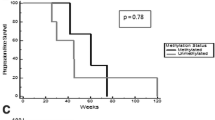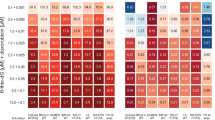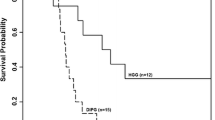Abstract
Telomerase activation is critical in many cancers including central nervous system (CNS) tumors. Imetelstat is an oligonucleotide that binds to the template region of the RNA component of telomerase, inhibiting its enzymatic activity. We conducted an investigator-sponsored molecular biology (MB) and phase II study to estimate inhibition of tumor telomerase activity and sustained responses by imetelstat in children with recurrent CNS malignancies. In the MB study, patients with recurrent medulloblastoma, high-grade glioma (HGG) or ependymoma undergoing resection received one dose of imetelstat as a 2-h intravenous infusion at 285 mg/m2, 12–24 h before surgery. Telomerase activity was evaluated in fresh tumor from surgery. Post-surgery and in the phase II study, patients received imetelstat IV (days 1 and 8 q21-days) at 285 mg/m2. Imetelstat pharmacokinetic and pharmacodynamic studies were performed. Of two evaluable patients on the MB trial, intratumoral telomerase activity was inhibited by 95 % compared to baseline archival tissue in one patient and was inevaluable in one patient. Forty-two patients (40 evaluable for toxicity) were enrolled: 9 medulloblastomas, 18 HGG, 4 ependymomas, 9 diffuse intrinsic pontine gliomas. Most common grade 3/4 toxicities included thrombocytopenia (32.5 %), lymphopenia (17.5 %), neutropenia (12.5 %), ALT (7.5 %) and AST (5 %) elevation. Two patients died of intratumoral hemorrhage secondary to thrombocytopenia leading to premature study closure. No objective responses were observed. Telomerase inhibition was observed in peripheral blood mononuclear cells (PBMCs) for at least 8 days. Imetelstat demonstrated intratumoral and PBMC target inhibition; the regimen proved too toxic in children with recurrent CNS tumors.


Similar content being viewed by others
References
Blackburn EH (1991) Structure and function of telomeres. Nature 350(6319):569–573. doi:10.1038/350569a0
Kim NW, Piatyszek MA, Prowse KR, Harley CB, West MD, Ho PL, Coviello GM, Wright WE, Weinrich SL, Shay JW (1994) Specific association of human telomerase activity with immortal cells and cancer. Science 266(5193):2011–2015
Shay JW, Bacchetti S (1997) A survey of telomerase activity in human cancer. Eur J Cancer 33(5):787–791. doi:10.1016/S0959-8049(97)00062-2
Komata T, Kanzawa T, Kondo Y, Kondo S (2002) Telomerase as a therapeutic target for malignant gliomas. Oncogene 21(4):656–663. doi:10.1038/sj.onc.1205072
Barszczyk M, Buczkowicz P, Castelo-Branco P, Mack SC, Ramaswamy V, Mangerel J, Agnihotri S, Remke M, Golbourn B, Pajovic S, Elizabeth C, Yu M, Luu B, Morrison A, Adamski J, Nethery-Brokx K, Li XN, Van Meter T, Dirks PB, Rutka JT, Taylor MD, Tabori U, Hawkins C (2014) Telomerase inhibition abolishes the tumorigenicity of pediatric ependymoma tumor-initiating cells. Acta Neuropathol (Berl) 128(6):863–877. doi:10.1007/s00401-014-1327-6
Ridley L, Rahman R, Brundler MA, Ellison D, Lowe J, Robson K, Prebble E, Luckett I, Gilbertson RJ, Parkes S, Rand V, Coyle B, Grundy RG, Children’s C Leukaemia group biological studies C (2008) Multifactorial analysis of predictors of outcome in pediatric intracranial ependymoma. Neuro-Oncol 10(5):675–689. doi:10.1215/15228517-2008-036
Didiano D, Shalaby T, Lang D, Grotzer MA (2004) Telomere maintenance in childhood primitive neuroectodermal brain tumors. Neuro-Oncol 6(1):1–8. doi:10.1215/S1152851703000176
Dorris K, Sobo M, Onar-Thomas A, Panditharatna E, Stevenson CB, Gardner SL, Dewire MD, Pierson CR, Olshefski R, Rempel SA, Goldman S, Miles L, Fouladi M, Drissi R (2014) Prognostic significance of telomere maintenance mechanisms in pediatric high-grade gliomas. J Neurooncol 117(1):67–76. doi:10.1007/s11060-014-1374-9
Kim CH, Cheong JH, Bak KH, Kim JM, Oh SJ (2006) Prognostic implication of telomerase activity in patients with brain tumors. J Korean Med Sci 21(1):126–130
Marian CO, Cho SK, McEllin BM, Maher EA, Hatanpaa KJ, Madden CJ, Mickey BE, Wright WE, Shay JW, Bachoo RM (2010) The telomerase antagonist, imetelstat, efficiently targets glioblastoma tumor-initiating cells leading to decreased proliferation and tumor growth. Clin Cancer Res 16(1):154–163. doi:10.1158/1078-0432.CCR-09-2850
Terali K, Yilmazer A (2016) New surprises from an old favourite: the emergence of telomerase as a key player in the regulation of cancer stemness. Biochimie 121:170–178. doi:10.1016/j.biochi.2015.12.001
Gryaznov SM, Jackson S, Dikmen G, Harley C, Herbert BS, Wright WE, Shay JW (2007) Oligonucleotide conjugate GRN163L targeting human telomerase as potential anticancer and antimetastatic agent. Nucleosides Nucleotides Nucleic Acids 26(10–12):1577–1579. doi:10.1080/15257770701547271
Ferrandon S, Malleval C, El Hamdani B, Battiston-Montagne P, Bolbos R, Langlois JB, Manas P, Gryaznov SM, Alphonse G, Honnorat J, Rodriguez-Lafrasse C, Poncet D (2015) Telomerase inhibition improves tumor response to radiotherapy in a murine orthotopic model of human glioblastoma. Mol Cancer 14:134. doi:10.1186/s12943-015-0376-3
Tefferi A, Lasho TL, Begna KH, Patnaik MM, Zblewski DL, Finke CM, Laborde RR, Wassie E, Schimek L, Hanson CA, Gangat N, Wang X, Pardanani A (2015) A pilot study of the telomerase inhibitor imetelstat for myelofibrosis. N Engl J Med 373(10):908–919. doi:10.1056/NEJMoa1310523
Baerlocher GM, Oppliger Leibundgut E, Ottmann OG, Spitzer G, Odenike O, McDevitt MA, Roth A, Daskalakis M, Burington B, Stuart M, Snyder DS (2015) Telomerase inhibitor imetelstat in patients with essential thrombocythemia. N Engl J Med 373(10):920–928. doi:10.1056/NEJMoa1503479
Thompson PA, Drissi R, Muscal JA, Panditharatna E, Fouladi M, Ingle AM, Ahern CH, Reid JM, Lin T, Weigel BJ, Blaney SM (2013) A phase I trial of imetelstat in children with refractory or recurrent solid tumors: a children’s oncology group phase I consortium study (ADVL1112). Clin Cancer Res 19(23):6578–6584. doi:10.1158/1078-0432.CCR-13-1117
Roth A, Harley CB, Baerlocher GM (2010) Imetelstat (GRN163L)–telomerase-based cancer therapy. Recent Results Cancer Res 184:221–234. doi:10.1007/978-3-642-01222-8_16
Ouellette MM, Liao M, Herbert BS, Johnson M, Holt SE, Liss HS, Shay JW, Wright WE (2000) Subsenescent telomere lengths in fibroblasts immortalized by limiting amounts of telomerase. J Biol Chem 275(14):10072–10076
Steinert S, Shay JW, Wright WE (2000) Transient expression of human telomerase extends the life span of normal human fibroblasts. Biochem Biophys Res Commun 273(3):1095–1098. doi:10.1006/bbrc.2000.3080
Mender I, Gryaznov S, Dikmen ZG, Wright WE, Shay JW (2015) Induction of telomere dysfunction mediated by the telomerase substrate precursor 6-thio-2′-deoxyguanosine. Cancer Discov 5(1):82–95. doi:10.1158/2159-8290.CD-14-0609
Acknowledgements
We acknowledge the outstanding clinical research support of Christopher Smith and Emily Carps and the regulatory support of Dr. Renee Doughman. This work was supported in part by Cincinnati Children’s Basic Science Research and the Clinical Translational, Outcomes and Health Services Redesign grant (R.D.), National Institute of Health Grant U01 CA81457 for the Pediatric Brain Tumor Consortium (M.F. and J.B.) and American Lebanese Syrian Associated Charities.
Author information
Authors and Affiliations
Corresponding author
Ethics declarations
Conflict of interest
None.
Rights and permissions
About this article
Cite this article
Salloum, R., Hummel, T.R., Kumar, S.S. et al. A molecular biology and phase II study of imetelstat (GRN163L) in children with recurrent or refractory central nervous system malignancies: a pediatric brain tumor consortium study. J Neurooncol 129, 443–451 (2016). https://doi.org/10.1007/s11060-016-2189-7
Received:
Accepted:
Published:
Issue Date:
DOI: https://doi.org/10.1007/s11060-016-2189-7




